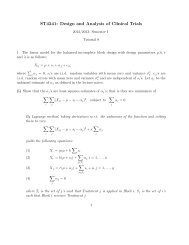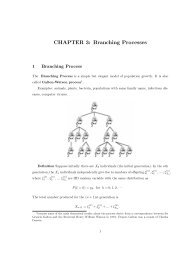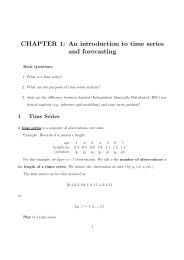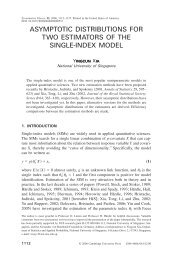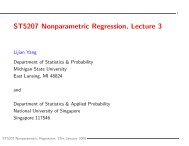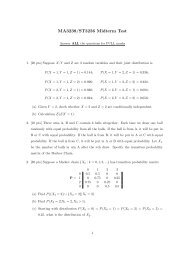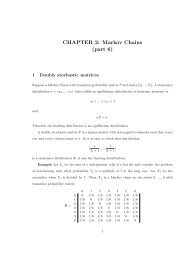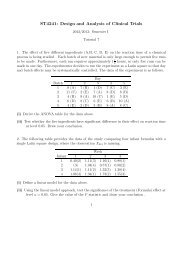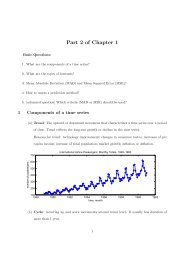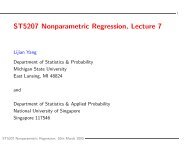Companion notes - The Department of Statistics and Applied ...
Companion notes - The Department of Statistics and Applied ...
Companion notes - The Department of Statistics and Applied ...
Create successful ePaper yourself
Turn your PDF publications into a flip-book with our unique Google optimized e-Paper software.
Notes on Mathematical <strong>Statistics</strong> <strong>and</strong> Data Analysis<br />
3e by J.A. Rice (2006)<br />
YAP Von Bing, <strong>Statistics</strong> <strong>and</strong> <strong>Applied</strong> Probability, NUS<br />
November 18, 2011<br />
1 Introduction<br />
<strong>The</strong>se <strong>notes</strong> were the result <strong>of</strong> a course on Mathematical <strong>Statistics</strong> for year-two undergraduates<br />
at the National University <strong>of</strong> Singapore <strong>of</strong>fered in Semester 1 (Fall) 2011. Topics covered were<br />
• Selected items in chapters 1-6, on probability<br />
• Chapter 7 Survey sampling: up to, but excluding 7.4 ratio estimation.<br />
• Chapter 8 Estimation: except for 8.6 Bayesian estimation.<br />
• Chapter 9 Testing hypotheses: up to, but excluding 9.7 hanging rootograms.<br />
<strong>The</strong> materials here are meant to enhance the very readable <strong>and</strong> useful book. Most <strong>of</strong> them<br />
were implemented in the course, some in a less polished state initially than presented here,<br />
but eventually tidied up. <strong>The</strong> others were not implemented, but I think are good ideas for a<br />
future course.<br />
2 Notation<br />
<strong>The</strong> following are some rules:<br />
1. A r<strong>and</strong>om variable is denoted by a capital Roman letter, <strong>and</strong> the corresponding small<br />
letter de<strong>notes</strong> its realisation. In Example A (page 213), there is “ ¯X = 938.5”. By<br />
the rule, “¯x = 938.5” is preferable. <strong>The</strong> phrase “r<strong>and</strong>om variable equals constant” is<br />
restricted to probability statements, like P(X = 1).<br />
2. An estimator <strong>of</strong> a parameter θ is a r<strong>and</strong>om variable, denoted by ˆθ. On page 262, the<br />
parameter is λ 0 , but the estimator is written ˆλ. By the rule, the estimator should be ˆλ 0 .<br />
A realisation <strong>of</strong> ˆθ is called an estimate, which is not denoted by ˆθ. In Example A (page<br />
261), the estimator <strong>of</strong> λ is ˆλ = ¯X. Later, there is “ˆλ = 24.9”. This would be rephrased<br />
as something like “24.9 is an estimate <strong>of</strong> λ”.<br />
1
3 Sampling<br />
3.1 With replacement, then without<br />
While simple r<strong>and</strong>om sampling from a finite population is a very good starting point, the<br />
dependence among the samples gets in the way <strong>of</strong> variance calculations. This is an obstacle to<br />
comprehending the st<strong>and</strong>ard error (SE). Going first with sampling with replacement, there are<br />
independent <strong>and</strong> identically distributed (IID) r<strong>and</strong>om variables X 1 , . . . , X n with expectation<br />
µ <strong>and</strong> variance σ 2 , both unknown constants. <strong>The</strong> sample mean ¯X is an estimator <strong>of</strong> µ, i.e.,<br />
its realisation ¯x is an estimate <strong>of</strong> µ. <strong>The</strong> actual error in ¯x is unknown, but is around SD( ¯X),<br />
which is σ/ √ n. This is an important definition:<br />
SE(¯x) := SD( ¯X)<br />
Now σ 2 has to be estimated using the data x 1 , . . . , x n . A reasonable estimate is v, the realisation<br />
<strong>of</strong> the sample variance<br />
V = 1 n∑<br />
(X i −<br />
n<br />
¯X) 2<br />
Since E(V ) = (n − 1)σ 2 /n, an unbiased estimator <strong>of</strong> σ 2 is<br />
S 2 =<br />
i=1<br />
n<br />
n − 1 V<br />
<strong>The</strong> approximation <strong>of</strong> the SE by √ v/n or s/ √ n is called the bootstrap. After the above is<br />
presented, we may go back to adjust the formulae for sampling without replacement from a<br />
population <strong>of</strong> size N. <strong>The</strong> estimator is still ¯X, but the SE should be multiplied by<br />
√<br />
1 − n − 1<br />
N − 1<br />
which is important if n is large relative to the population size. <strong>The</strong> unbiased estimator <strong>of</strong> σ 2<br />
is (N − 1)S 2 /N, which matters only if N is small.<br />
<strong>The</strong> r<strong>and</strong>om variable V is usually written as ˆσ 2 . I reserve ˆσ 2 for a generic estimator <strong>of</strong> σ 2 .<br />
For example, using the method <strong>of</strong> moments, ˆµ = ¯X <strong>and</strong> ˆσ 2 = V .<br />
3.2 S 2 or V ?<br />
Let X 1 , . . . , X n be IID with mean µ <strong>and</strong> variance σ 2 , both unknown. Consider confidence<br />
intervals for µ. S 2 must be used when the t distribution applies, i.e., when the X’s are<br />
normally distributed. Otherwise, n should be large enough for the normal approximation to<br />
be good, in which case there is little difference between the two.<br />
For the calculation <strong>of</strong> SE, S 2 is more accurate.<br />
3.3 Sampling without replacement<br />
Let X 1 , . . . , X n be a simple r<strong>and</strong>om sample from a population <strong>of</strong> size N with variance σ 2 .<br />
Lemma B (page 207) states: if i ≠ j, then cov(X i , X j ) = −σ 2 /(N − 1). <strong>The</strong> pro<strong>of</strong> assumes,<br />
without justification, that the X’s are exchangeable, or more specifically, the conditional<br />
distribution <strong>of</strong> X j given X i is the same as that <strong>of</strong> X 2 given X 1 .<br />
2
3.4 Systematic sampling<br />
On page 238, systematic sampling is defined. Essentially, the population is arranged in a<br />
rectangle. A row (or column) is chosen at r<strong>and</strong>om (equal probability) as the sample. It is<br />
said that periodic structure can cause bias. This statement cannot apply to the sample mean,<br />
which is unbiased for the population mean. Perhaps the point is: its variance is larger than<br />
that for a simple r<strong>and</strong>om sample <strong>of</strong> the same size.<br />
4 Estimation<br />
4.1 Motivation<br />
<strong>The</strong> main idea is a natural extension from sampling with replacement. IID r<strong>and</strong>om variables<br />
X 1 , . . . , X n are used to construct an estimator ˆθ, a r<strong>and</strong>om variable, for a parameter θ, an<br />
unknown constant. Given data, i.e., realisations x 1 , . . . , x n , the corresponding realisation <strong>of</strong><br />
ˆθ is an estimate <strong>of</strong> θ. <strong>The</strong> actual error in the estimate is unknown, but is roughly SD(ˆθ).<br />
General definition:<br />
SE(estimate) := SD(estimator)<br />
<strong>The</strong> SE <strong>of</strong>ten involves some unknown parameters. Obtaining an approximate SE, by replacing<br />
the parameters by their estimates, is called the bootstrap.<br />
4.2 Sample size<br />
It is important to have a strict definition <strong>of</strong> sample size:<br />
sample size = the number <strong>of</strong> IID data<br />
<strong>The</strong> sample size is usually denoted by n, but here is a confusing example. Let X ∼ Binomial(n, p).<br />
<strong>The</strong> sample size is 1, not n (Wouldn’t it be so confusing to write “n is 1, not n.”?). That it<br />
is equivalent to n IID Bernoulli(p) r<strong>and</strong>om variables is the job <strong>of</strong> sufficiency.<br />
4.3 What does θ mean?<br />
Often, θ de<strong>notes</strong> two things, both in the parameter space Θ: (a) a particular unknown constant,<br />
(b) a generic element. This double-think is quite unavoidable in maximum likelihood,<br />
but for method <strong>of</strong> moments (MOM), it can be sidestepped by keeping Θ implicit. For example,<br />
the estimation problem on pages 255-257 can be stated as follows: For n = 1, 207,<br />
assume that X 1 , . . . , X n are IID Poisson(λ) r<strong>and</strong>om variables, where λ is an unknown positive<br />
constant. Given data x 1 , . . . , x n , estimate λ <strong>and</strong> find an approximate SE. <strong>The</strong> MOM estimator<br />
ˆλ is constructed without referring to the parameter space: the positive real numbers.<br />
4.4 Alpha particle emissions (page 256)<br />
10220/1207 ≈ 8.467, not close to 8.392. In Berk (1966), the first three categories (0, 1, 2<br />
emmisions) were reported as 0, 4, 14, <strong>and</strong> the average was 8.3703. Since 8.3703 × 1207 =<br />
10102.95, the total number <strong>of</strong> emissions is most likely 10103. Combined with the reported<br />
s 2 = 8.6592, the sum <strong>of</strong> squares is close to 95008.54, likely 95009. Going through all possible<br />
counts for 17, 18, 19, 20 emissions, the complete table is reconstructed, shown on the next<br />
page.<br />
3
Emissions Frequency<br />
0 0<br />
1 4<br />
2 14<br />
3 28<br />
4 56<br />
5 105<br />
6 126<br />
7 146<br />
8 164<br />
9 161<br />
10 123<br />
11 101<br />
12 74<br />
13 53<br />
14 23<br />
15 15<br />
16 9<br />
17 3<br />
18 0<br />
19 1<br />
20 1<br />
Total 1207<br />
Table 1: Reconstructed Table 10 A <strong>of</strong> Berk (1966). ¯x = 8.3703, s 2 = 8.6596.<br />
4.5 Rainfall (pages 264-265)<br />
Let X 1 , . . . , X 227 be IID gamma(α, λ) r<strong>and</strong>om variables, where the shape α <strong>and</strong> the rate λ are<br />
unknown constants. <strong>The</strong> MOM estimator <strong>of</strong> (α, λ) is<br />
( )<br />
(ˆα, ˆλ)<br />
¯X2<br />
=<br />
V , ¯X<br />
V<br />
<strong>The</strong> SEs, SD(ˆα) <strong>and</strong> SD(ˆλ), have no known algebraic expressions, but can be estimated by<br />
Monte Carlo, if (α, λ) is known. It is unknown, estimated as (0.38,1.67). <strong>The</strong> bootstrap<br />
assumes<br />
SD(ˆα) ≈ SD( ̂0.38), SD(ˆλ) ≈ SD( ̂1.67)<br />
where ( ̂0.38, ̂1.67) is the MOM estimator <strong>of</strong> (0.38,1.67). This odd-looking notation is entirely<br />
consistent. To get a realisation <strong>of</strong> ̂0.38, generate x 1 , . . . , x 227 from the gamma(0.38,1.67)<br />
distribution <strong>and</strong> compute ¯x 2 /v.<br />
<strong>The</strong> double-act <strong>of</strong> Monte Carlo <strong>and</strong> boostrap can be used to assess bias. Define<br />
By the bootstrap,<br />
bias(0.38) = E(ˆα) − α<br />
E(ˆα) − α ≈ E( ̂0.38) − 0.38<br />
which can be estimated by Monte Carlo. <strong>The</strong> bias in (0.38,1.67) is around (0.10,0.02). <strong>The</strong><br />
maximum likelihood estimates have smaller bias <strong>and</strong> SE.<br />
4
4.6 Maximum likelihood<br />
Unlike MOM, in maximum likelihood (ML) the two meanings <strong>of</strong> θ clash, like an actor playing<br />
two characters who appear in the same scene. <strong>The</strong> safer route is to put the subscript 0 to the<br />
unknown constant. This is worked out in the Poisson case.<br />
Let X 1 , . . . , X n be IID Poisson(λ 0 ) r<strong>and</strong>om variables, where λ 0 > 0 is an unknown constant.<br />
<strong>The</strong> aim is to estimate λ 0 using realisations x 1 , . . . , x n . Let λ > 0. <strong>The</strong> likelihood at λ is the<br />
probability <strong>of</strong> the data, supposing that they come from Poisson(λ):<br />
n∏ λ x i<br />
e −λ<br />
L(λ) = Pr(X 1 = x 1 , . . . , X n = x n ) =<br />
x i !<br />
On (0, ∞), L has a unique maximum at ¯x. ¯x is the ML estimate <strong>of</strong> λ 0 . <strong>The</strong> ML estimator is<br />
ˆλ 0 = ¯X.<br />
<strong>The</strong> distinction between λ 0 <strong>and</strong> λ helps make the motivation <strong>of</strong> maximum likelihood clear.<br />
However, for routine use, λ 0 is clunky (I have typed tutorial problems where the subscript<br />
appears in the correct places; it is hard on the eyes). <strong>The</strong> following is more economical, at<br />
the cost <strong>of</strong> some mental gymnastics.<br />
Let X 1 , . . . , X n be IID Poisson(λ) r<strong>and</strong>om variables, where λ > 0 is an unknown constant.<br />
[Switch.] <strong>The</strong> likelihood function on (0, ∞) is<br />
n∏ λ x i<br />
e −λ<br />
L(λ) = Pr(X 1 = x 1 , . . . , X n = x n ) =<br />
x i !<br />
which has a unique maximum at ¯x. [Switch back.] <strong>The</strong> ML estimator <strong>of</strong> λ is ˆλ = ¯X.<br />
With some practice, it gets more efficient. <strong>The</strong> r<strong>and</strong>om likelihood function is a product <strong>of</strong><br />
the respective r<strong>and</strong>om densities:<br />
n∏ λ X i<br />
e −λ<br />
L(λ) =<br />
X i !<br />
i=1<br />
Since L has a unique maximum at ¯X, ˆλ = ¯X.<br />
<strong>The</strong> distinction between a generic θ <strong>and</strong> a fixed unknown θ 0 is useful in the motivation<br />
<strong>and</strong> in the pro<strong>of</strong> <strong>of</strong> large-sample properties <strong>of</strong> the ML estimator (pages 276-279). Otherwise,<br />
θ 0 can be quietly dropped without confusion.<br />
4.7 Hardy-Weinberg equilibrium (pages 273-275)<br />
By the Hardy-Weinberg equilibrium, the proportions <strong>of</strong> the population having 0, 1 <strong>and</strong> 2 a<br />
alleles are respectively (1 − θ) 2 , 2θ(1 − θ) <strong>and</strong> θ 2 . Hence the number <strong>of</strong> a alleles in a r<strong>and</strong>om<br />
individual has the binomial(2,θ) distribution; so the total number <strong>of</strong> a alleles in a simple<br />
r<strong>and</strong>om sample <strong>of</strong> size n ≪ N has the binomial(2n, θ) distribution.<br />
Let X 1 , X 2 , X 3 be the number <strong>of</strong> individuals <strong>of</strong> genotype AA, Aa <strong>and</strong> aa in the sample.<br />
<strong>The</strong> number <strong>of</strong> a alleles in the sample is X 2 + 2X 3 ∼ binomial(2n, θ), so<br />
( )<br />
X2 + 2X 3<br />
var<br />
=<br />
2n<br />
θ(1 − θ)<br />
2n<br />
<strong>The</strong> Monte Carlo is unnecessary. <strong>The</strong> variance can also be obtained directly using the expectation<br />
<strong>and</strong> variance <strong>of</strong> the trinomial distribution, but the binomial route is much shorter.<br />
Since there is no cited work, it is not clear whether the data were a simple r<strong>and</strong>om sample<br />
<strong>of</strong> the Chinese population <strong>of</strong> Hong Kong in 1937. If not, the trinomial distribution is in doubt.<br />
5<br />
i=1<br />
i=1
4.8 MOM on the multinomial<br />
Let X = (X 1 , . . . , X r ) have the multinomial(n, p) distribution, where p is an unknown fixed<br />
probability vector. <strong>The</strong> first moment µ 1 = np. Since the sample size is 1, the estimator <strong>of</strong> µ 1<br />
is X. <strong>The</strong> MOM estimator <strong>of</strong> p is X/n. This illustrates the definition <strong>of</strong> sample size.<br />
Let r = 3. Under Hardy-Weinberg equilibrium, p = ((1 − θ) 2 , 2θ(1 − θ), θ 2 ). <strong>The</strong>re are<br />
three different MOM estimators <strong>of</strong> θ.<br />
4.9 Confidence interval for normal parameters (page 280)<br />
Let x 1 , . . . , x n be realisations from IID r<strong>and</strong>om variables X 1 , . . . , X n with normal(µ, σ 2 ) distribution,<br />
where µ <strong>and</strong> σ 2 are unknown constants. <strong>The</strong> (1 − α)-confidence interval for µ:<br />
(<br />
¯x − √ s t n−1 (α/2), ¯x +<br />
s )<br />
√ t n−1 (α/2)<br />
n n<br />
is justified by the fact that<br />
(<br />
P ¯X − √ S t n−1 (α/2) ≤ µ ≤ ¯X + S )<br />
√ t n−1 (α/2) = 1 − α<br />
n n<br />
Likewise,<br />
(<br />
P<br />
nV<br />
χ 2 n−1(α/2) ≤ σ2 ≤<br />
)<br />
nV<br />
= 1 − α<br />
χ 2 n−1(1 − α/2)<br />
justifies the confidence interval for σ 2 :<br />
(<br />
)<br />
nv<br />
χ 2 n−1(α/2) , nv<br />
χ 2 n−1(1 − α/2)<br />
This illustrates the superiority <strong>of</strong> V over ˆσ 2 .<br />
4.10 <strong>The</strong> Fisher information<br />
Let X have density f(x|θ), θ ∈ Θ, an open subset <strong>of</strong> R p . <strong>The</strong> Fisher information in X is<br />
defined as<br />
[ ]<br />
∂<br />
2<br />
I(θ) = −E<br />
∂θ log f(X|θ) 2<br />
When the above exists, it equals the more general definition<br />
[ ] 2<br />
∂<br />
I(θ) = E<br />
∂θ log f(X|θ)<br />
In all the examples, <strong>and</strong> most applications, they are equivalent, <strong>and</strong> the first definition is<br />
easier to use.<br />
6
4.11 Asymptotic normality <strong>of</strong> ML estimators<br />
Let ˆθ be the ML estimator <strong>of</strong> θ based on IID r<strong>and</strong>om variables X 1 , . . . , X n with density f(x|θ),<br />
where θ is an unknown constant. Let I(θ) be the Fisher information in X 1 . Under regularity<br />
conditions, as n → ∞, √<br />
nI(θ)(ˆθ − θ) → N(0, 1)<br />
Note the Fisher information <strong>of</strong> a single unit <strong>of</strong> the IID X’s, not that <strong>of</strong> all <strong>of</strong> them, which is<br />
n times larger.<br />
For large n, approximately<br />
)<br />
ˆθ ∼ N<br />
(θ, I(θ)−1<br />
n<br />
I(θ) −1 plays a similar role as the population variance in sampling.<br />
4.12 Asymptotic normality: multinomial, regression<br />
This is essentially the content <strong>of</strong> the paragraph before Example C on page 283. Let X =<br />
(X 1 , . . . , X r ) have a multinomial(n, p(θ)) distribution, where θ is an unknown constant. Let<br />
I(θ) be the Fisher information. <strong>The</strong>n as n → ∞,<br />
√<br />
I(θ)(ˆθ − θ) → N(0, 1)<br />
Pro<strong>of</strong>: X has the same distribution as the sum <strong>of</strong> n IID r<strong>and</strong>om vectors with the multinomial(1,p(θ))<br />
distribution. <strong>The</strong> ML estimator <strong>of</strong> θ based on these data is ˆθ (by sufficiency or direct calculation).<br />
<strong>The</strong> Fisher information <strong>of</strong> a multinomial(1,p(θ)) r<strong>and</strong>om vector is I(θ)/n. Now apply<br />
the result in the previous section.<br />
If the X’s are independent but not identically distributed, like in regression, asymptotic<br />
normality <strong>of</strong> the MLEs does not follow from the previous section. A new definition <strong>of</strong> sample<br />
size <strong>and</strong> a new theorem are needed.<br />
4.13 Characterisation <strong>of</strong> sufficiency<br />
Let X 1 , . . . , X n be IID r<strong>and</strong>om variables with density f(x|θ), where θ ∈ Θ. Let T be a function<br />
<strong>of</strong> the X’s. <strong>The</strong> sample space S is a disjoint union <strong>of</strong> S t across all possible values t, where<br />
S t = {x : T (x) = t}<br />
<strong>The</strong> conditional distribution <strong>of</strong> X given T = t depends on θ in general. If for every t, it is the<br />
same for every θ ∈ Θ, then T is sufficient for θ. This gives a characterisation: T is sufficient<br />
for θ if <strong>and</strong> only if there is a function q(x) such that for every t <strong>and</strong> every θ ∈ Θ<br />
f(x|t) = q(x),<br />
x ∈ S t<br />
This clarifies the pro<strong>of</strong> <strong>of</strong> the factorisation theorem (page 307).<br />
Logically, sufficiency is a property <strong>of</strong> Θ. “T is sufficient for Θ” is more correct.<br />
7
4.14 Problem 4 (page 313)<br />
Let X 1 , . . . , X 10 be IID with distribution P(X = 0) = 2θ/3, P(X = 1) = θ/3, P(X = 2) =<br />
2(1 − θ)/3, P(X = 3) = (1 − θ)/3, where θ ∈ (0, 1) is an unknown constant. <strong>The</strong> MOM<br />
estimator <strong>of</strong> θ is<br />
˜θ = 7 6 − ¯X<br />
2<br />
<strong>The</strong> ML estimate based on the given numerical data can be readily found. That <strong>of</strong> general<br />
x 1 , . . . , x 10 , or the ML estimator, is hard because the distribution <strong>of</strong> X 1 is not in the form<br />
f(x|θ). One possibility is<br />
[ ] y0<br />
[ ] y1<br />
[ ] y2<br />
[ ] y3<br />
2 1 2 1<br />
f(x|θ) =<br />
3 θ 3 θ 3 (1 − θ) 3 (1 − θ) , y j = 1 {x=j}<br />
It follows that the ML estimator is<br />
ˆθ = Y n<br />
where Y is the number <strong>of</strong> times 0 or 1 turn up.<br />
This is an interesting example. ˜θ <strong>and</strong> ˆθ are different, both are unbiased. ˆθ is efficient, but<br />
not ˜θ:<br />
θ(1 − θ)<br />
var(ˆθ) = , var(˜θ) = 1 θ(1 − θ)<br />
+<br />
n<br />
18n n<br />
<strong>The</strong>y illustrate relative efficiency more directly than on pages 299-300, <strong>and</strong> the sample size<br />
intepretation <strong>of</strong> relative efficiency. Y is sufficient for θ, so E(˜θ|Y ) has smaller variance than<br />
˜θ. Another clue to the superiority <strong>of</strong> ML: If 0, 1, 2, 3 are replaced by any other four distinct<br />
numbers, the ML estimator stays the same, but the MOM estimator will be fooled into<br />
adapting. Fundamentally, the distribution is multinomial.<br />
5 Hypothesis tests<br />
Let X = (X 1 , . . . , X r ) be multinomial(n, p(θ)), where θ ∈ Θ, an open subset <strong>of</strong> R. Let ˆθ be<br />
the ML estimator <strong>of</strong> θ based on X. <strong>The</strong>n the null distribution <strong>of</strong> the Pearson’s<br />
r∑<br />
X 2 [X i − np i (ˆθ)] 2<br />
=<br />
np i (ˆθ)<br />
i=1<br />
is asymptotically χ 2 r−2. Let X be obtained from a Poisson distribution, so that θ = λ ∈<br />
(0, ∞). <strong>The</strong> above distribution holds for ˆλ based on X. Example B (page 345) assumes it<br />
also holds for ˆλ = ¯X, the ML estimator based on the raw data, before collapsing. This is<br />
unsupported. An extreme counter-example: collapse Poisson(λ) to the indicator <strong>of</strong> 0, i.e., the<br />
data is binomial(n, e −λ ). Since r = 2, theory predicts X 2 ≡ 0, as can be verified directly, but<br />
plugging ˆλ = ¯X into X 2 gives a positive r<strong>and</strong>om variable. Using R, the correct ML estimate<br />
<strong>of</strong> λ in Example B is 2.39, giving X 2 = 79.2.<br />
6 Minor typographical errors<br />
• Page A39: In the solution to Problem 55 on page 324, the asymptotic variance has 1+2θ<br />
in the denominator, not 1 + θ. Refer to Fisher (1970) page 313.<br />
• Page A26: Bliss <strong>and</strong> Fisher (1953) is on pages 176-200.<br />
8



